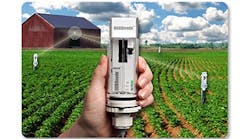[sidebar id="1"]
Machines and robot builders and their customers have used wired sensors and switches successfully for decades, so why should they now consider wireless sensors?
"Wireless sensors are potential solutions for applications where wiring and its maintenance is deemed impractical or not economically feasible," says Peter Engstrom, managing director of Steute Industrial Controls. "Some good examples would be remote locations where distributed electrical power is not readily available, rotary equipment on which flexible cables wear or suffer damage, and locations where cable runs are extremely long or the installation cost is considered excessive."
SEE ALSO: Wireless Sensors: The Data You Want
Tim Pitterling, product manager for industrial Ethernet infrastructure at Siemens Industry, has other reasons to use wireless sensors. "Sweet spots for wireless technologies include applications with high or continuous motion, such as automated guided vehicles, monorails or any applications using trailing cables or slip rings," he says. "Even highly engineered trailing or torsion cables still have to be replaced after a specific number of bending cycles to avoid unplanned downtime."
Wireless is also more flexible and rugged than wired installations. "With wireless implementations, plant personnel can simply move assembly machines to new locations and turn on the wireless network, eliminating the need to re-route or install new cables," points out Joseph Citrano, senior global product manager at Honeywell Sensing and Control.
"Factories can be dirty places, with lots of different types of liquids used for dipping, spraying or coating products, any of which can easily destroy the insulation around nearby control or power wires. A battery-operated wireless sensor or switch with suitable, rugged packaging can withstand and function well in the most inhospitable factory environments."
Wireless sensors can communicate directly with a wireless receiver mounted close to a controller— with the controller hardwired to the receiver. For sensors mounted further from the controller or in locations with limited communication paths to the controller, sensors can communicate wirelessly to transmitters and/or repeaters, which in turn are wirelessly connected to the receiver.
Another alternative is to use a wireless remote I/O station. "A practical approach in many cases is to use a remote I/O station to gather local sensor values, and then transfer that data wirelessly to the main controller," Pitterling suggests. "Taking this route, wireless technology is used to compliment traditional wired solutions."
Citrano points out that most wireless sensors don't require power wiring, with energy supplied through either a battery or an energy-harvesting device. Energy harvesters are integrated into a wide variety of wireless sensors.
"Robust energy-harvesting mechanisms are capable of meeting the duty cycle and life expectancy requirements typically encountered in wireless sensing industrial applications," Engstrom explains. "These generators have eliminated the need for a battery power source in a variety of mechanically actuated devices such as limit, pull-wire, pushbutton, selector, key-operated and foot switches."
Similar to wireless sensors, associated components such as transmitters and repeaters are designed to use very little power, making it practical to use energy harvesters or batteries. When batteries are used, life spans of components usually run into years, reducing required maintenance.
A clear sign of the emergence of practical wireless sensor solutions is the emergence of standards. "Profibus and Profinet Int'l. (PI) created FA WSAN, a standard for factory automation wireless sensor and actuator networks," reports Carl Henning, deputy director of PI North America.
"FA WSAN was designed for applications such as robots from the beginning because its original use case was for robotic arms where cables are prone to failure from pinching or flexing," Henning adds. "Since the FA WSAN specification doesn't include how devices are powered, vendors are free to use wired power or use sensors powered by other means such as radio waves.
"RFID devices usually are powered by the radio waves that read the devices, and it's the same with some factory wireless sensors," Henning points out. "ABB provided a basis for the FA WSAN spec with its WISA technology."




